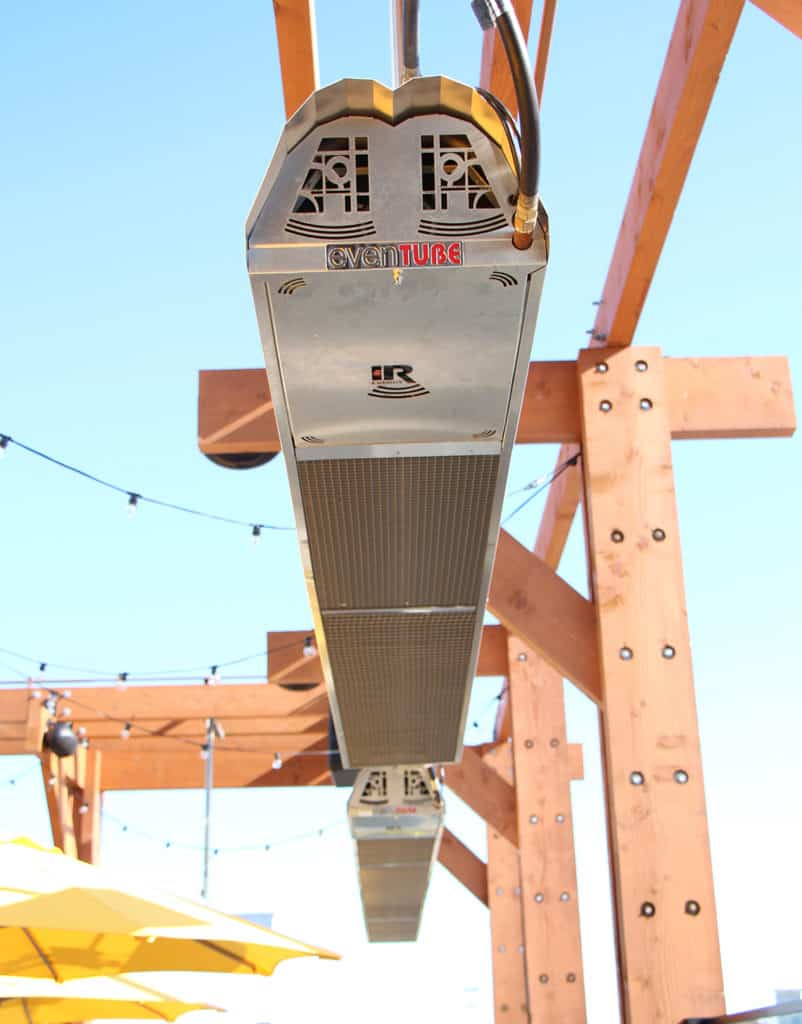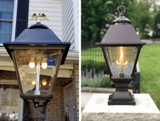Installing Gas Patio Heaters
Are you disappointed when the weather gets cold and you can’t enjoy your outdoor spaces anymore? Do you wish you could comfortably be outside all year-round? If you and your family love your outdoor spaces, natural gas patio heaters are an investment that you’ll never regret.
What are Natural Gas Patio Heaters?
About Gas Patio Heaters
Gas patio heaters are heating systems that use natural gas to heat your outdoor space. They are great options for homeowners or commercial spaces with a well-ventilated deck, patio, or backyard space.
Types Of Gas Patio Heaters

There are a few different styles of gas patio heaters, each with different benefits depending on your space. American Gas Lamp Works is proud to provide a range of IR Energy‘s top-tier gas patio heaters, known for their exceptional efficiency and innovative design. These are:
- Portable, Free Standing Heaters
- Portable, free-standing heaters can be used without electricity. You can move them to different areas of your outdoor space, or they can travel with you for parties or events. The EvenGLO from American Gas Lamp Works is available as a portable or permanently fixed heater, and can also come as a hanging mushroom option to maximize patio floor space.
- Fixed, Wall-Mounted Heaters
- Wall mount heaters are ideal for smaller areas, those with low or busy ceilings, or areas where you don’t want to take up floor space. The Habanero from American Gas Lamp Works comes in three different styles, making it ideal for patio spot heating and allowing it to work in an area of any size.
- Fixed, Overhead-Mounted Heaters
- Hanging patio heaters work well in areas with higher ceilings, and they have more intense and even heat footprints. The EvenTUBE heater from American Gas Lamp Works is less than 7” deep and comes in four different lengths, offering a sleek heating solution for an outdoor space of any size.
Gas Patio Heater Benefits

In addition to the warmth they provide, gas patio heaters are a great option because of the number of benefits they offer.
- Easy to maintain — Gas patios heaters are easier to maintain in the long run than other types of outdoor heaters.
- Affordable fuel option — Comparatively, natural gas is the least expensive fuel option.
- Fuel never runs out — Because they connect directly to your existing gas line, natural gas patio heaters will offer continuous heat for as long as needed, without ever running out of fuel.
- Large range of sizes and options — Gas patio heaters come in many different sizes and options, offering a range of coverage for all types of spaces.
- Permanent — Once they’re installed, natural gas patio heaters are permanent and out of your way.
- Full range of heat — With the different sizes and options available, you are sure to find full heat coverage for whatever space you’re looking for.
Are Infrared Patio Heaters Better Than Gas?
The choice between infrared and gas patio heaters depends on your specific needs. Infrared heaters are efficient, providing immediate heat and targeting objects and people directly, which is advantageous in windy conditions. They are energy-efficient, safer (as they don’t emit carbon monoxide), quieter, and require less maintenance. However, gas heaters are better for larger spaces due to their higher heat output and create ambient warmth. They also offer flexibility in placement as they don’t need an electrical source. The decision hinges on the size of the area, safety concerns, energy efficiency, and whether immediate or ambient heat is preferred.
Installing Gas Patio Heaters
Who Installs Gas Patio Heaters?
We recommend coordinating the installation of gas heaters with trained professionals like plumbers, gas specialists, and HVAC technicians. They can handle the gas lines and determine the best location for the heaters by finding out the recommended clearance to combustibles.
Existing Gas Line V. Installing A New Gas Line
Natural gas heaters require gas lines, so if you don’t have them, you’ll need to get them installed. If you already have existing gas lines, a professional can use them to install your gas heaters.
Installing Different Styles Of Gas Patio Heaters

Wall and ceiling-mounted styles of natural gas patio heaters require an electrical supply, along with the gas supply, to work. Most can plug into a standard wall outlet, but you may need to have the proper wiring installed by a licensed professional. Portable, free standing heaters only require the gas supply to work.
The Cost of Installing a Gas Patio Heater
There are different factors that will contribute to your gas patio heater installation costs. This includes the style and model of the heater you purchase, whether or not you have existing gas lines, and the type of professional that you hire to install gas lines and your heater.
When hiring a professional to install your gas heater, prices usually range anywhere between $400-$600 if you have an existing gas line to tap into. If you do not, the installation of gas lines will up your costs. Nationally, it can range anywhere from $120 to $1,350 to install a new gas line.
Pricing* for gas patio heaters from American Gas Lamp Works varies by make and model:
- The EvenGLO offers fixed natural gas & propane models starting at $1,800.00, portable natural gas & propane models starting at $2,700.00, and portable propane models (for use with 20 lb. tank) starting at $2,940.00.
- The Habanero comes in 3′ natural gas models starting at $2,250.00 and 4′ natural gas models starting at $2,500.00.
- The EvenTUBE has a wider range of options:
- 9′ outdoor natural gas and propane models starting at $2,500.00.
- 17′ outdoor natural gas and propane models starting at $3,250.00.
- 12′ indoor/outdoor natural gas and propane models starting at $2,650.00.
- 22′ indoor/outdoor natural gas and propane models starting at $3,150.00.
*Prices effective 11/1/23. Subject to change. Please contact AGLW for current pricing.
Why Are Natural Gas Patio Heaters So Expensive?
Several factors affect the price of a natural gas patio heater. Their installation requires a permanent gas line, often needing professional setup, which adds to the cost. They are built with high-quality, durable materials to withstand long-term outdoor use, increasing their price.
Additionally, gas patio heaters are more efficient in heat output, utilizing advanced technology that elevates manufacturing costs. Safety features for stable operation and leak prevention also increase the price.
Furthermore, their rarity in the market leads to higher prices due to lower production volumes. Despite the initial expense, they are a cost-effective long-term investment for outdoor spaces.
Are Gas Patio Heaters Worth It?
Gas patio heaters can be a valuable investment, particularly if you frequently use outdoor spaces and require efficient heating. They efficiently warm larger areas, making patios or decks comfortable even in cooler weather.
These heaters are convenient. They don’t need electrical connections and offer mobility. The initial purchase cost, ongoing fuel expenses, and maintenance should be considered.
Safety is crucial, as gas patio heaters should be operated in well-ventilated areas to avoid carbon monoxide risks. If the benefits of effective heating and enhanced outdoor ambiance align with your needs and budget, gas patio heaters can be worth the investment.
Safety Considerations When Installing Gas Patio Heaters
Gas heaters require well-ventilated areas and should be kept away from children and pets. If you’re limited on space, have young kids or pets, or own a restaurant, hanging or flush-mounted heaters will be your best option, as they’re installed out of the way.
Other safety considerations include:
- Only place heaters on completely level surfaces that can hold their weight.
- Do not place heaters in areas with a lot of wind, low-hanging tree branches, or plants.
- Never hang clothes or other materials on or near the heater.
- Make sure to check the clearances offered by the manufacturer.
- If you have a standing heater, turn it off before moving it to another location.
How Safe Are Gas Patio Heaters?
Gas patio heaters are generally safe when used responsibly. Safety hinges on proper placement, maintenance, and operation.
They should be positioned on stable surfaces, away from flammable materials. Regular maintenance is crucial to check for leaks and ensure secure connections. Adequate ventilation is essential, especially in enclosed areas, to prevent the buildup of harmful gases like carbon monoxide.
Many gas patio heater models come with safety features like automatic shut-off for tipping or overheating. User awareness is also key. Following the manufacturer’s instructions and understanding safety practices is vital.
While there are risks with any gas appliance, adherence to these guidelines can make gas patio heaters a safe outdoor heating option.
Are Gas Patio Heaters Safe To Use Indoors?
Gas patio heaters are not safe to use indoors. They are specifically designed for outdoor use because they vent and emit heat.
When used indoors, gas patio heaters pose a significant risk of carbon monoxide poisoning, as they release this harmful gas during operation. Indoor environments lack the necessary ventilation to safely disperse these emissions, leading to potentially dangerous levels of carbon monoxide accumulation.
Additionally, the high heat output of these heaters can create fire hazards in enclosed spaces. It’s crucial to follow the manufacturer’s guidelines and only use gas patio heaters in well-ventilated outdoor areas to ensure safety. It’s important to choose a heating solution that is designed and safe for indoor use if heating is needed indoors.
Repair & Maintenance of Gas Patio Heaters
Low-level maintenance can be performed by the homeowner. Before performing any required maintenance, make sure your gas patio heater is turned off and cooled.
If dealing with a gas line issue, it is important to reach out directly to the manufacturer or your local plumber, gas specialist, or HVAC technician.
Frequently Asked Questions
Do Gas Patio Heaters Use A Lot Of Gas?
Gas patio heaters can vary in their consumption based on size, efficiency, and usage patterns.
Generally, a standard gas patio heater can consume between 20,000 to 40,000 BTUs (British Thermal Units) per hour. This means that using a 20 lb propane tank, which typically holds about 430,000 BTUs, could last between 10 to 20 hours of continuous use, depending on the heater’s BTU rating and efficiency.
It’s important to note that higher BTU ratings don’t always mean higher gas consumption, as efficient models can produce more heat with less fuel. Factors like outdoor temperature, wind conditions, and heater placement can also affect gas usage.
To minimize gas consumption, it’s advisable to use the heater judiciously and consider models with adjustable settings to control the heat output and fuel usage better.
Do Gas Patio Heaters Need To Be Covered?
Covering gas patio heaters is a recommended practice, especially when they are not in use. This precaution helps protect the heater from various elements like rain, snow, dust, and debris, which can potentially damage its components over time.
A cover also guards against rust and wear caused by exposure to the environment, thereby extending the heater’s lifespan. While some high-quality patio heaters are designed to withstand outdoor conditions, using a cover can still be beneficial for maintaining their appearance and functionality.
It’s important to ensure the heater is completely cool before covering it to avoid any risk of fire or damage to the cover. Regularly using a cover when the heater is not in use is a simple yet effective way to keep it in good condition for longer.
Can Gas Patio Heaters Be Left Outside?
Gas patio heaters are designed for outdoor use and can generally be left outside. Their ability to withstand outdoor conditions varies based on material quality and weather exposure.
While they are built to endure typical outdoor elements, harsh weather like heavy rain, snow, or extreme temperatures can impact their lifespan.
Using a protective cover when the heater is not in use is recommended to shield it from moisture, dust, and debris. In areas with severe weather, storing the heater indoors or in a sheltered area during extreme conditions or prolonged non-use is advisable. Regular maintenance is also key to ensuring long-term safety and functionality.
If you’re unsure which heater is best for your business or home, contact us to get personalized assistance from American Gas Lamp Works today.

Author: Patrick Jardini, President
Patrick Jardini is the President of American Gas Lamp Works, a manufacturer and distributor of gas and electric lighting, outdoor heaters, and custom fire bowls. Since purchasing the business, Mr. Jardini has focused on expanding both products and brand awareness through direct sales and strategic partnerships with gas utility providers. Patrick is a Pittsburgh native, Air Force veteran, and MBA graduate from the University of Pittsburgh, and has a professional background in metals production, sales, and marketing.







